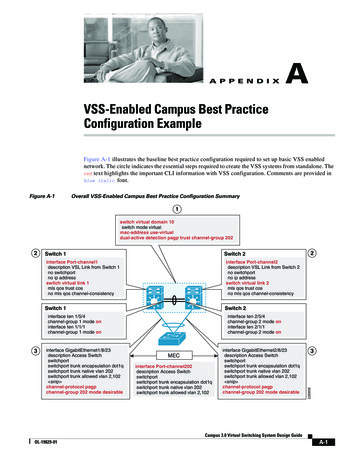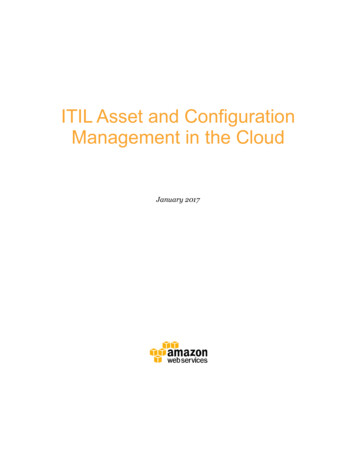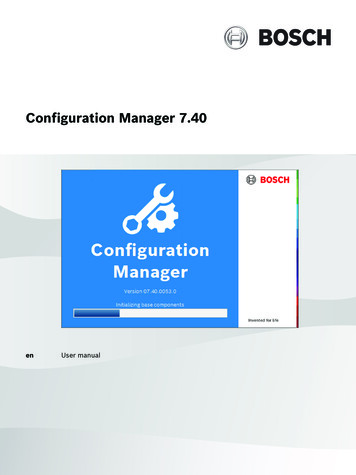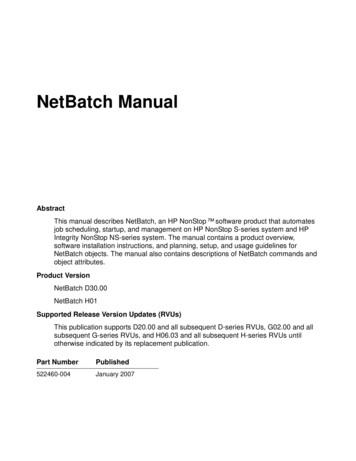
Transcription
Design and Implementation of ConfigurationManagement for the MPLS NetworkDong-Jin Shin, Hyung-Woo Choi, Ho-Cheal Kim, Young-Tak KimDept. of Info. & Comm. Eng., Graduate School, Yeungnam University,214-1, Daedong, Kyungsan-Si, Kyungbook, 712-749, KOREA(dongdang@yumail.ac.kr, shout0713@empal.com, LS has been developed to manage the massive high-speed Internet traffic efficiently. The majoradvantages of the MPLS are fast label switching mechanism to increase the packet forwarding capability, andconnection oriented traffic engineering to provide flexible load balancing in the transit network. The MPLS canprovide efficient transit networking based on the connection-oriented LSP to support the QoS of VPN (VirtualPrivate Network). It can also support the differentiated service provisioning with DiffServ-aware-MPLS structure.For efficient network management, it is essential to gather the information of the exact network topology andresource; but it is difficult to manually discover the network topology of a large scale network with the legacynetwork management system. In this paper, we propose a Configuration Management system for MPLS networkwith auto-discovery of physical network topology and MPLS LSP virtual topology. The proposed configurationmanagement system also provides the MPLS-VPN configuration and provisioning function.Ⅰ. IntroductionFor the efficient management of the large trafficvolume at high speed Internet, MPLS has beendeveloped to support the effective traffic engineeringfunction for the massive traffic through the Internet[1].MPLS combines layer 3 routing and layer 2 switching toprovide (i) fast packet forwarding with high speed labelswitching, and (ii) traffic engineering based on theconnection oriented CR-LSP (Constraint-based RoutingLabel Switched Path). The MPLS can support thedifferentiated service provisioning with DiffServ-awareMPLS[3].IETF draft documents describe the operation andstructure of the MPLS networking, and explain thesignaling protocol, such as CR-LDP and RSVP-TE. TheIETF documents define the MPLS MIB and propose themanagement method based on the SNMP[2].For efficient network management, it is essential togather the information of exact network topology andresource; but it is difficult to manually discover thenetwork topology of a large scale network with thelegacy network management system.Configuration management basically providesinstallation supports, status and control, and serviceprovisioning functions. The configuration managementfunctions support the preparation and initialization ofnetwork resources for service provisioning, the collectionof operational status data of the network node system[4].Since the access & update operation of SNMP MO takeslonger time than CLI(Command Line Interface), we needa management module that can use both SNMP interfaceand CLI interface of the network node system to provideefficient and diverse management function.In this paper, we design and implement theConfiguration Management function for MPLS networkwith auto-discovery of network topology and the MPLSLSP topology[3]. The proposed configurationmanagement system also provides the MPLS-VPNconfiguration and provisioning function. The rest of thispaper is organized as follows. In section II, we reviewthe major functions of the configuration management. Insection III, we propose an auto-discovery of MPLSnetwork topology and traffic trunk LSPs. In section IV,the VPN configuration in the MPLS network is proposedand implemented. Finally, in section V, we makeconclusion.1
Ⅱ.Major FunctionsManagementofConfiguration2.1 NMS structure of the NGI networking systemFig.1 shows the structure of the NGI Networkingsystem with the TINA(Telecommunications InformationNetworking Architecture). The NMS structure shown inthe Fig.2 has the layered architecture: the Physical layer,the Data-link layer, and the IP layer.Fig. 1. The NGI Networking system for MPLSnetworkmodule measures the throughput and the utilization ofrouter or workstation, CPU utilization, load status, anddisk capacity and utilization. When this module isrequested, the appointed traffic monitoring is executedand the result is reported to the administrator through theGUI. The measured data is stored in DB as Log modules.The CLI(Command Line Interface) module wasimplemented in the GIA module to interface themeasurement of the traffic transmission of the router viacertain link/port. So we can monitor the amount of traffictransmission of the router LSP/port by real time.2.2 Configuration management functionsThe main goal of the Configuration Management is toadministrate the life cycle of the installed networkresources, such as creation/deletion of the resources,status change of the resources, etc. The detailedconfiguration management functions are categorized asProvisioning, Status and control, and Installation support,as shown in Table 1.Table 1. Configuration management functionsFig. 2. NMS(Network Management System) forlayered network managementEach layer is managed by the layer’s configurationmanager, performance manager, connection manager,and fault manager. RMAgent (Real-time MonitoringAgent) was implemented to measure the protocol trafficfor the performance analysis, and traffic analysisaccording to the services. And RMAgent in GIA(Generic Interface Adapter) is connected to GUI by theRMInterface.The GIA module consists of three modules: CLI, Realtime Monitoring module(RM), and RM interface. RMInstallation support function should provide theinstallation and removal of network resource. It coversthe insertion or deletion of a node system from thenetwork. Installation Support function also performs theinitialization procedure of the network managementfunctional modules. At initialization stage, theCP(Connection Performer) creates CP MO(ManagedObject) for the Connection Management, thePM(Performance Manager) creates PM MO for thePerformance Management, the FM(Fault Manager)creates FM MO for the Fault Management, and theAD(Auto Discovery) creates AD MO for the Auto2
discovery operation for MPLS network topology andMPLS LSP topology.Provisioning consists of procedures which arenecessary to bring the network resource (e.g.,physical/logical resource of a network element level ornetwork level) into service, not including the installation.Once the network resource is ready for serviceprovisioning, the network topology configurationprovisioning function initializes them. MO forOperational Status has status attribute that is eitherdisabled or enabled, and is read-only. MO forAdministrational Status has status attribute that is eitherlocked or unlocked, and is read-write.Status and control function provides the capability tomonitor and control the operational status of networkresource[4]. The MOs for Status and Control function areifType(), ifSpeed(), ipAddr() and ipRouteProto().factory-service structure where the Configurator has thefactory object functions such as creation, deletion andinvocation. MO are created by the Configurator, and thecreated objects are registered in the MIT. MIT isconsisted of the IOR(Interoperable Object Reference)that uses the Naming Service of CORBA. If theconfigurator wants to invoke the MO, it must access themanagement object through the IOR in MIT[5].Fig. 5. PhyTC StructureFig. 3. Structure of the Configuration management(2) Relation to Other Management DomainsAs shown in Fig.6, PhyTC interacts with user agent,SNMP adaptor and MIT (Management Information Tree).User agent interacts with user via GUI. A user isrepresented as a unit module to the network managementsystem by the user agent. Configurator interacts withparticular module by the user’s request. SNMP Adaptorgets and sets the management information of the createdMO via the SNMP. Management functions on thecreated MO, such as registration, calling and deletion,are performed through the MIT that provides the namingof the MO instance.Fig. 4. Structure of Topology ConfiguratorFig. 6. Relation to Other management Domains2.3 Configuration Management of Physical layer(1) PhyTC StructurePhyTC(Physical Topology Configurator) has theIf the operator GUI requests a creation of an MO, theuser agent sends a request message to the Configurator.The Configurator creates the MO based on the received3
information from the User agent and directly getsinformation from the devices through CORBA/SNMPAdaptor. The created MO is registered at MIT, and othermanagement domains access the MO through the MIT.shows the MIT of physical layer.(3) Design of the PhyTC components.We use the Link and Node MOs for managing thephysical resource layer. Physical information of thenetwork device consists of information that includeslocation, device type, state of connection, port number,and other information about the physical hardwareconfiguration. Table 2 and Table 3 show the link objectand node objects, respectively.Table 2. Link objectFig. 7. MIT of Physical LayerTable 3. Node object(4) MIT of Physical layerMIT of PhyTC is realized by the naming service ofCORBA. MC (Managed Component) registers MOs inthe MIT when it instantiates a logical MO, and otheradministration functions access the registered MOsthrough the MIT. Management information is stored ateach management component, and MIT keeps track ofthe location at MOs by CORBA naming tree. Fig.72.4 Configuration management of Data-link layer(1) Structure of DLTC(Data Link TopologyConfigurator)Data link topology configurator(DLTC) has alsoFactory/Service structure, and Configurator of DLTCcreates MO as shown in Fig.8.Fig. 8. Structure Data Link TopologyConfigurator(DLTC)The Configurator performs the Factory function, andit creates, deletes and maintains MO of datalink layer.Factory object registers the data link MO to Naming Treewhen an MO is created, and delivers the reference of the4
relevant object using the recognized MOs Nameinformation when it requests MO information. AndFactory object deletes any unnecessary MO. Created MOoffers interface that allows the access from user oranother administration function[6].MOs in each object can be accessed through theCORBA's IOR (Interoperable Object Reference). Therelated MOs for the configuration management of MPLSnetwork are MPLSLNW, MPLSLND, MPLSRouter andNWCTP. Fig.9 and Fig.10 show the definition of theMPLSRouter/NWCTP object using the CORBA IDL.Fig. 11. DLTC MITFig. 9. Definition of the MPLSRouter object using theCORBA IDLFig. 10. Definition of the NWCTP object using theCORBA IDL(2) DLTC MITDLTC's MIT is also implemented using the CORBANaming Service. MC (Managed Component) registersthe created MOs in the MIT after it instantiates thelogical MOs, and other administration functions accessthe registered MOs via MIT. Management informationsare stored at the management component, and MIT keepstrack the location by CORBA naming tree. Fig.8 showsthe MIT of the DLTC.(3) Managed Object for MPLS Network ManagementMOs to manage the MPLS network are defined usingCORBA IDL. MPLS network is defined by MPLSLNWobject, and divided by domain subnetwork throughMPLSLND object. LSR router that performs MPLSfunction is modeled by MPLSRouter object andLSR(Label Switching Router)'s interfaces are defined byNWCTP(NetWork Connection Termination Point) object.MPLSRouter contains attributes such as m name,m nodeType,m vendor,m modelNumber,m description,m snmpCommunity,m location,m startX,m startY,m endX,m endY,m NWCTPCount and m NWCTPList.NWCTPcontains attributes such as m portType, m ifAddr,m totalBandwidth,m availableBandwidthandm mplsInterfaceInLabelsUsed.2.5 Interactions of configuration management withother domains(1) Interactions between DLTC and PhyTCFig.11 shows the interactions between DLTC andPhyTC (Physical Layer Topology Configurator). IfJavaGUI module calls updateAll() function, the DLTCreceives the reference of router object from the MIT, andcollects information about the topology from the PhyTC.The DLTC collects the information about the bandwidthof each interface from GIA(Generic interface Adapter).The Configurator of DLTC creates the MOs of theMPLSRouter and the NWCTP from the collectedinformation.5
Fig. 12. Interaction between DLTC and PhyTC(2) Relation to the connection managementInteraction structure of the distributed component isdepicted in Fig.13. Each component should be linkedwith the GUA(Generic User Agent) for user interface,and should be linked with the GIA to get the networkconfiguration device or the network information.PhyTC(Physical Topological Configurator) gets theforemost configuration information through the JavaGUI(Graphic User Interface), and composes theconfiguration information of the physical layer based onthese configuration information.DLTC gets the topology information of the managednetwork from the PhyTC, the bandwidth information ofmanaged network from the GIA(Generic InterfaceAdaptor), and composes the configuration information ofthe datalink layer using these information. Theinitialization work of the DLCP can be executed by theUpdateData() function defined in the IDL interface of theDLCP as well as when the DLCP is initialized. TheDLCP gets the node information such as topology andbandwidth of the datalink layer from the DLCP when theinitialization is completed.After the initialization of the DLCP, the DLCP canreceive connection setup and release request for the LSPfrom the GUI or other modules.Fig. 13. Interaction structure of the distributedComponentsThe CP(Connection Performer) and TC(TopologicalConfigurator) interaction procedures are as follows: 1When the TC is booted, it registers theConfigurator that is static object to the MIT2 The CP approaches and gets IOR (Interoperable Object Reference) about Configurator of the TC tothe MIT.3 CP interacts with IPTC through the Configurator IOR. The Configurator of the TC is Factory object,and it controls the whole remainder service objects.Therefore, the CP can approach to all objects thatare included to the TC.Fig.14 shows the interactions between DLTC andDLCP. After the initialization of the management system,Fig. 14. Interaction structure between the DLCP andthe DLTC2.6 Interactions with other management functionsThe configuration management module establishes thetopology of communication network, and analyzes theLSP's QoS (bandwidth, priority order, jitter, delay), andmanages LSPs for transit network configuration. Severalfunctions must be added to the existent anagement based on MPLS:- Transmission path or exchange devices areclassified and are managed to support DiffServfunction and to support the traffic groomingfunction.- According to the resource class, we must be6
--able to differentiate the transmission delay,packet error rate, fault occurrence rate, andmaximum capacity of the network resource.In order to handle the link fault or the nodeerror, we must be able to make the backup pathusing the SRLG(Shared Risk Link Group)identifier.Dynamic resource discovery and Real-timemap generation.Reporting function about the network topology,used network, used ip from the subnetwork,composition information of the subnetworkend-to-end point.Fig. 15. Configuration of MPLS routerTable 4. Information from ingress edgerouter(3620 B)Ⅲ. Auto-discovery of MPLS networkconfiguration3.1 Auto-discovery of network topologyAquiring the information of network topology, nodesystem and link/port configuration is the first step innetwork management. For a large scale network, themanual initialization of configuration database is tediousand time consuming. Also the afterward updates in thenetwork configuration should be continuously updated inthe network configuration database. For this purpose, wedesigned and implemented an auto-discovery module forthe configuration management of MPLS networks. Thescenario for auto-discovery of network topology is asfollows:Step1. NMS accesses any router using the telnetemulator.Step2. Get the information of the Neighbor nodes andown node as shown in Table4, Table5 andTable6 (CDP-Cisco Discovery Protocol, TDPTag Distribution Protocol).Step3. NMS constructs the network topology.Step4. Repeat step1 step3 until all routers areinvestigated.We configured a small test-bed network with fourCISCO 3620 series and two CISCO 7204 series routersas shown in Fig.15 to evaluate the configurationmanagement of MPLS network. NMS can access eachrouter by using the Telnet emulator, and get theconfiguration information from the router. From theresult of auto-discovery, we can construct the networktopology as shown in Fig.15Table 5. Information from egress edgerouter(3620 D)7
Table 6. Information from core router (7204 G)Fig. 16. MPLS LSP topology3.2 Auto-discovery of MPLS LSP topologyIn addition to the auto-discovery of physical networktopology and physical layer information of nodes andlinks, we need another auto-discovery nodule for theMPLS-layer LSPs. The procedure of auto-discovery forLSP Topology over MPLS network is as follows:Step1. Access any MPLS LSR, and find preestablished LSP(tunnel), get the information ofsource node(ingress node) and the destinationnode(egress node).Step2. NMS accesses one of the ingress node of anLSP (e.g. the 3620 B router) using the telnetinterface.Step3. Get the information about the 3620 B routerwhich is the next address of the LSP (e.g.10.0.10.2) as shown in Table 7.Step4. Access the 7204 G router (IP address :10.0.30.2) using the address information of the7204 G router.Step5. Get information of egress LSR information(e.g. 3620 D router which is the neighbor of7204 G router in Fig. 16), from the nextaddress of LSP tunnel.Step6. Access the egress LSR (3620 D router) usingthe address information of the 3620 Drouter(IP address : 10.0.40.1).Step7. Get the information of the established LSPsand its neighbor router(s).Step8. Repeat step 5 step 7 for each LSP foundfrom the MPLS LSR.From the gathered information, we can configure theMPLS LSP topology.Table 7. LSP information from ingress edgeLSR(3620 B)Table 8. LSP information from egress edgeLSR(3620 D)Table 9. LSP information from core LSR(7204 G)8
Ⅳ. VPN Configuration in the MPLSNetworkin the MIT according to Factory /Service as shown inFig.17[2].Table 10. TC MOs and attributes of MPLS VPNMS4.1 MPLS VPNThe VPN provides the private networking functions,such as security, reliability, easy management andprivate address. The cost of VPN based on publicInternet is much less than the physically separatedprivate network using its own dedicated network. In thissection, we design and implement an MPLS-VPNmanagement system that configures efficiently theMPLS VPN to satisfy QoS requirements. MPLS VPNmanagement system collects informations of MPLS VPNnetwork using the SNMP[2].4.2 MO of Topology Configurator for MPLS VPNIn order to support the MPLS-VPN configurationmanagement, TC (Topology Configurator) has Vpn,PE(provider edge), Site and VRF(VPN Routing andForwarding instance) MOs of the VPN. Each VPN ismodeled as the Vpn MO in the TC. The Vpn MO has theName, ID of the VPN and PE list. Vpn-name object isnecessary to register in the MIT. PE MO has the ID ofthe PE router, PE’s VRF list and Site list of the PE. SiteMO has IP address of the CE router of the Site andreference for the CPM. VRF MO possesses the importtarget attribute and the export target attribute of the VRFTable[2].4.3 Design of Management Information Tree forMPLS-VPNIt is necessary to integrate the distributed MIB for theintegrated management at the network viewpoint. And itis essential for effective MIB/MIT configuration andoperation. In this paper, we designed and implementedthe distributed MIT based on the naming service of theCORBA. The naming Service of the CORBA providesfederations for several Naming Trees. The whole MITcan be divided into several smaller Naming Trees, andthe distributed MIT can be easily extended and canreduce the processing burden even if the managednetwork grows to a large scale.ConfMO is the Factory MO that creates the VPNobject. The VPN object creates the PE object whichcreates the CE and VRF object. Created MOs areregistered in the MIT. Connector, Performer,TrapReceiver and CPM functional modules resister MOsFig. 17. MIT of MPLS-VPNMS4.4 MPLS-VPN Configuration procedureComputational component (Conf) creates MOs forVPN, PE, Site and VRF. It implements the managedfunctions according to the following procedure:① User requests the Configurator to create MOthrough GUI.② Configurator establishs the information of9
subnetwork through the GIA, and it requests thenecessary information.③ subnetwork information is transmitted toConfigurator through GIA.④ Configurator creates MO to represent the collectedinformation.⑤ Created MO transmits reference to Configurator.⑥ Configurator accesses directly the MO through thereference.⑦ GUI accesses directly the MO through the receivedreference.⑧ VPN MO executes the requested operationaccording to the command of SNMP.⑨ GIA interacts with MPLS node systems, receivesthe answers, and sends the response of the SNMPcommand to the VPN MO.⑩ VPN MO transmits the responses to GUI.Fig. 18. MPLS-VPN Configuration4.5 MPLS VPN provisioning in Cisco router(1) VPN Routing and Forwarding Tables(VRFs)The VPN routing and forwarding table (VRF) is a keyelement in the MPLS VPN technology. VRFs exist onPEs only. A VRF is a routing table instance, and morethan one VRF can exist on a PE. A VPN can contain oneor more VRFs on a PE. The VRF contains routes thatshould be available to a particular set of sites. VRFs useCEF(Cisco Express Forwarding) technology, thereforethe VPN must be CEF-enabled[7]. A VRF is associatedwith the following elements:IP routing tableDerived forwarding table, based on the CiscoExpress Forwarding (CEF) technologyA set of interfaces that use the derivedforwarding tableA set of routing protocols and routing peers thatinject information into the VRF(2) VRF Implementation ConsiderationsWhen implementing VPNs and VRFs, Ciscorecommends to keep the following considerations inmind[7]:A local VRF interface on a PE is notconsidered a directly-connected interface in atraditional sense.The global routing table and the per-VRFrouting table are independent entities. CiscoIOS commands apply to IP routing in a globalrouting table context.You can issue a standard Telnet command froma CE router to connect to a PE router. However,from that PE, you must issue the followingcommand to connect from the PE to the CE:telent CERouterName /vrf vrf nameThe MPLS VPN backbone relies on theappropriate Interior Gateway Protocol (IGP)that is configured for MPLS, for MPLS, forexample, EIGRP or OSPF.(3) VRF Configuration CommandsThe configuration commands to create a VRF instanceare as follows[7]:Fig. 19. MPLS-VPN Configuration procedure10
Table 11. The configuration commands to create aVRF instance(4) GIA(Generic Interface Adapter) adaptation forMPLS-VPN configurationTo configure the VPN network, GIA receives theConfigurator’s request for VPN configurations related tothe sub-network topological information. In this process,GIA contacts the PE router and investigates the LSP’sinformation about the operation parameters and so on.GIA requests LSP creation to the PE router according tothe VRF information. GIA transmits the VPN setup (orrelease) request to the PE router through Command LineInterface(CLI) module located in GIA according to theVRF information: VRF name, import target, and exporttarget. So that one VPN path can be successfullyconstructed with VRF table, RD and other informationswhich were transmitted to GIA. Table 12 explains themapping relation between VPN component and GIAparameter for the implementation of VPN network. Alsothe GIA can obtain each LSP operation parameters on PErouter.Table 12. VPN parameter mapping for GIAVPN componentsGIA transmitparameterVRF namestruct VRFRoute Distinguisherstruct RD infoExport targetTo NodeImport targetFrom NodeLSP informationstruct LSP infoLSP operationparametersmaxBw, totalBw,delay, priority,setup priority,hold priority,load shareresource; but it is difficult to manually discover thenetwork topology of a large scale network with thelegacy network management system. The main goal ofthe Configuration Management is to administrate the eletion of the resources, status change of theresources, etc.). The configuration management functionshould provide Provisioning, Status and control andInstallation support.In this paper, we designed and implemented theconfiguration management system for MPLS network.The proposed MPLS configuration management systemperforms auto-discovery of the physical networktopology and the MPLS LSP topology. The MPLSconfiguration management system also supports theconfiguration of VPN(Virtual Private Network) based onMPLS network.References[1] Bruce Davie, Yakov Rekhter, "MPLS: technologyand applications," Morgan Kaufmann, 2000.[2] Hea-Eun Moon, "Design and Implementation ofNetwork Management System for QoS guaranteedBGP/MPLS-VPN," M.S. Thesis, YeungNam Univ.,2002.[3] Young-Tak Kim, "NGI Internet Traffic Engineering,"Lecture Note, Dept. of Information & comm. Eng.Graduate school, Yeungnam Univ. 2002. 9.[4] TINA-C, "Network Resource Architecture Version3.0," NR v3.0 97 02 10, Feb. 10. 1997.[5] Hea-Eun Moon, Seung-Ho Seo, Yun-Kyung Ra,Young-Tak Kim, "Design and Complementation ofPhysicallayerConfigurationManagementComponent for Integrated and DistributedManagement Structure," Korean Institute ofCommunication Sciences(KICS), 2001. 7.[6] Hea-Eun Moon, "Configuration managementfunction of Data-link Layer," TR-YNUANT-02TINA-00, Technical Report, ANTLab. YeungnamUniv., 2002.[7] Cisco VPN Solutions Center, “MPLS Solution UserGuide,” Cisco VPN documents. 2002.Ⅴ. ConclusionFor efficient network management, it is essential togather the information of exact network topology and11
Dong-Jin Shin1994.2 : received B.S. inElectrinic Eng. from Keungjiluniversity2001.2 : received. M.D. inElectronic Eng. from Yeungnamuniversity2002.3 - : under Ph.D. course in Information &Communication Eng. of Yeungnam UniversityResearch Area : ATM/B-ISDN, NGI, QoS measurementof MPLS TEHyung-Woo Choi2002.2 : received B.S. inInformation & Communication Eng.from Yeungnam University2002.3 - : under M.D. course inInformation & Communication Eng.of Yeungnam UniversityResearch Area : MPLS/VPN, NGI and TEYoung-Tak Kim1984.2 : received B.S. in ElectronicEng. from Yeungnam university1986.2 : received M.D. in Electric &Electronic Eng. from KAIST1990.2 : received Ph.D. in Electric &Electronic Eng. from KAIST1990.3-1994.8 : worked as a Member of Technical Staff& Section Leader of Telecommunication NetworkResearch Lab. in Korea Telecom.1994.9 - : Assistant professor and associate professor inthe Dept. of information & Communication Eng., collageof Eng., Yeungnam Univ.Research Area : MPLS, GMPLS, DiffServ, IN, TINA,TMN, NGI and TEHo-Cheal Kim1989.2 : received B.S. in ElectronicEng. from Keungbook university1999.2 : received M.D. MultimediacommunicationEng.fromYeungnam university1999.3 - : under Ph.D. course incommunication Eng. of YeungnamMultimediaUniversity1989.1-1995.7 : worked as a junior researcher, R&DCenter, Samsung Display Devices(SDI)1995.8-1996.4 : worked as a assistant Manager,Technical Support Team, Commercial VehicleDepartment, Samsung Havey Industry2001.3- : Full-time Instructor, computer & informationdepartment, UlSan College.Research Area : Mobile-IP, NGI, MPLS, SNMP, TMN,TINA12
discovery operation for MPLS network topology and MPLS LSP topology. Provisioning consists of procedures which are necessary to bring the network resource (e.g., physical/logical resource of a network element level or network level) into service, not including the installation. Once the network resource is ready for service provisioning, the .











